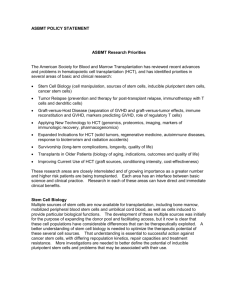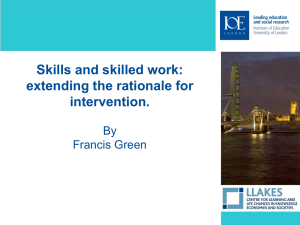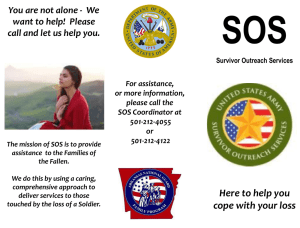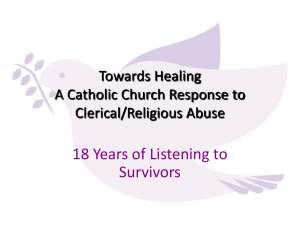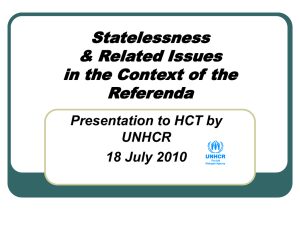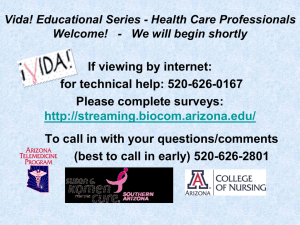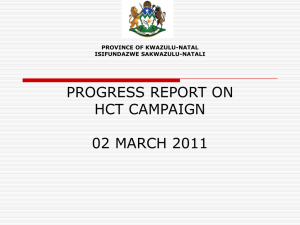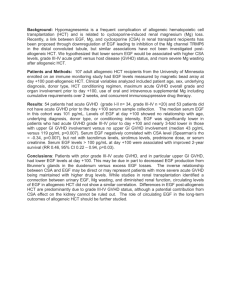Dr. Weisdorf - American Society for Blood and Marrow Transplantation
advertisement
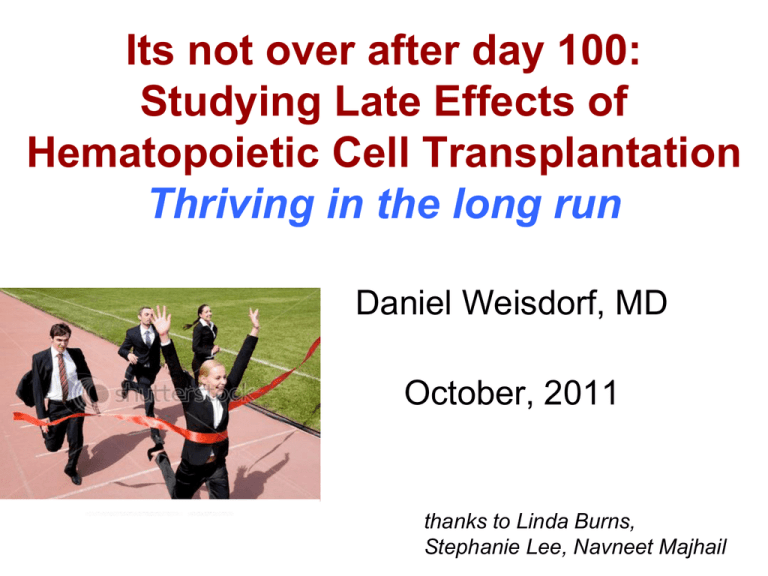
Its not over after day 100: Studying Late Effects of Hematopoietic Cell Transplantation Thriving in the long run Daniel Weisdorf, MD October, 2011 thanks to Linda Burns, Stephanie Lee, Navneet Majhail Allo sib HCT 97 HTN One Survivor’s History: Nearly the whole story Chronic GVHD mouth, GI tract, skin --- 98 99 00 Hypogonadism Herpes zoster 01 02 03 Hip arthroplasty Osteoporosis Renal insufficiency Secondary hyperparathyroidism Cataracts 04 05 06 Tongue dysplasia LRD renal tx AVN hip Vertebral compression fractures Esophageal strictures Lipid panel Overview • What is the problem • Recommended screening and preventive practices – Organ problems & Second Cancers – Joint Recommendations of the EBMT, CIBMTR, ASBMT (Rizzo et al BBMT 2006; 12:136) – Update being submitted for publication • Prospective trial challenges – Specific organ problems – Guides for Health Screening – BMT Survivors’ Study Leaving the Transplant Center Challenges in studying Late effects • The problem…. Too many issues Incidence & risk factors not well defined Patients are remote from HCT center Chronic morbidity; not acute Less pressing than cancer or GVHD So it gets less attention HCT oncologists may not be eager 1o care docs How big is the Problem? • 30,000-40,000 transplants each year • Increasing number of patients cured • Sequelae cause substantial morbidity • Optimizing outcomes requires: – Prevention – Early detection of complications – Mitigation of disability It’s a big puzzle Non-HCT related co-morbidities Transplant long-term effects Getting older concerns Transplant late effects Relapse What are the Problems? Several categories •Later onset medical problems eyes, bones, fertility, thyroid, dental etc •Risk factors for later or progressive injury to heart, kidneys, liver metabolic, vascular, viral •2nd cancers What are other Problems? •Later manifestations of peri-HCT illness Neurocognitive Psychiatric Lungs Good care can limit morbidity • Screen for the signs/symptoms – H&P, Labs, Imaging – Educate patients for self-screening • Screen for the risk factors – Metabolic syndrome -- cardiovascular – Subclinical -- early intervention Identifying the problems • Early detection – 2nd cancers – Who should get screening Late mortality: in 2 year disease free survivors Bhatia, Blood, 2007 Late causes of death (2 yr) Chronic GVHD 25% Relapse 50% Infection 7% Secondary ca 7% Other 4% Organ failure 7% Median age at HCT: 26 years Most received marrow from HLA-id siblings Socie et al, NEJM 1999 Bhatia et al, Blood 2007 Late causes of death (5 yr) Relapse 14% Chronic GVHD 11% Unknown 4% Infection 17% Other 9% Respiratory 7% Cardiovasc 10% Secondary ca 28% 75% of really late deaths Median age at HCT: ~ 32 years Most received marrow from HLA-id siblings N=2160, 286 deaths Martin P, JCO 2010 Chronic health conditions in 2 year disease-free survivors Gr 3-5 illnesses 35% at 10 y N=1022 HLA-ID sib Median FU 7.3 yrs Sun CL et al, Blood 2010 Any Chronic health conditions: 10 year survivors N=366 survivors + 306 sibs Median FU 15 yrs (10-28) 70% @15 yrs; 40% severe/life threatening Kersey, Sun CL et al, ASH 2011 Healthy Behaviors: Survivors vs. Sibs Survivors not better at screening--mammograms Armenian, BMT, 2011 Survivors slightly better at trying to stay healthy Armenian, BMT, 2011 It’s no longer a question of staying healthy. It’s a question of finding a sickness you like. -Jackie Mason Major Risk Factors Chemotherapy Immunosuppressants, Chronic GVHD and Steroids TBI Immune deficiency Chronic GVHD Late infections LATE EFFECTS Fertility, hypogonadism Growth and development Thyroid dysfunction Dental disease Cataracts Second malignancies Neurocognitive dysfunction Sicca syndrome Osteoporosis Osteonecrosis Lung dysfunction Iron overload Psychosocial Adjustment • 65% report fatigue and sleeping disorders • 25% problems with intimacy • Occupational disability • Depression in patient and caregivers Recommendation: High vigilance, minimal screening every 6 months Adverse Psychological Outcomes: Survivors vs. their Sibs CL Sun et al, 2011 Adverse Psychological Outcomes: Survivors: Improvements over tme CL Sun et al, 2011 Nervous System • 20% impaired memory, attention/verbal fluency • Calcineurin-induced CNS toxicity • Leukoencephalopathy • Peripheral neuropathy – Chemotherapy – cGVHD Cataracts and TBI Benyunes et al. Int J Radiat Oncol Biol Phys 1995;32:661. Oral Complications Secondary to TBI and cGHVD – Decreased saliva production – Intra-oral malignancies (cGHVD) – Increased risk of dental caries Recommendations: Dental evaluation at 6-12 months post transplant: caries, adequacy of saliva production, dental hygiene, ? fluoride treatments Endocrine Abnormalities • Thyroid dysfunction – Subclinical-compensated hypothyroidism – Overt hypothyroidism – Autoimmune thyroid disease • Hypoadrenalism • Growth retardation/delayed puberty • Fertility/hypogonadism Recommendations: Yearly screening of thyroid function; annual gynecologic/endocrine assessment for women and in men per symptoms; consider hormone replacement Pulmonary Late Effects • 15-40% of patients • Factors: – – – – cytoxic agents irradiation infections immune-mediated lung injury • Restrictive lung disease • Chronic obstructive lung disease Recommendations: Controversial – screen at one year (allo HCT) or by symptoms Hepatitis Prospective EBMT study in “post screening” era Locasciulli A et al. Transplantation 1994:14:833 HBsAg (%) HCV-RNA (%) SCT recipients 3.1 6.0 “de novo” infections 2.0 7.4 Positive donors 2.6 3.6 Recommendation: LFTs yearly, monitor viral load, liver bx in HCV Renal • True incidence of end-stage disease unknown • Glomerulonephritis, nephrotic syndrome • Dysfunction related to chemotherapy, TBI, age, antimicrobials, immunosuppressants Metabolic Syndrome Metabolic Syndrome • • • • • Transplant at City of Hope or U of MN 1974-1998 HCT = 1276; siblings 383 Survived ≥2 yrs post transplant Median age at transplant = 32.9 yrs Median f/u = 7.1 yrs Baker KS et al, 2005 Compared with their siblings, allo HCT survivors were: • 4.1 x more likely to report diabetes • 2.3 x more likely to report hypertension • 7.9 x more likely to report stroke There were no differences in auto HCT survivors and their siblings Osteonecrosis • Total dose/duration of steroids and TBI are risk factors • Mean time from transplant 18 months • MRI required for diagnosis • Sites - Hip 80% - Knee 10% Recommendation: Screening is not recommended; perform MRI if symptomatic Osteoporosis Characterized by reduced bone mass and increased susceptibility to fracture Normal Osteoporosis Bone Loss in HCT • Varying degrees in up to 50% of adult pts after allo HCT • Conflicting data in auto HCT (females at greater risk) • Greatest bone loss in first 6 months Factors Predisposing to Bone Loss • Glucocorticoid – decreases in bone formation and vit D3 concentration • • • • • • • • Cyclosporine/tacrolimus Hypogonadism TBI Hypomagnesemia Reduced physical activity Direct effect of GVHD on bone cells Abnormal cytokine-mediated bone turnover G-CSF Second Malignancies • • • • • • 3372 consecutive patients 1974 - 2001 Malignant (78%) and non-malignant diseases Median age 24 years (range 0.1-67) Auto (35%), MRD (42%), URD (23%) 78% received TBI containing prep • Median f/u = 5 yrs (range 0.5-25) • Person years of f/u = 10,494 years Baker et al. J Clin Onc 2003;21:1352 Second Malignancies • 147 post-transplant malignancies/137 pts • 8.1 fold increased risk • Increased risk for MDS/AML, NHL/PTLPD, HL, and solid tumors • Solid tumors – melanoma, brain, oral Second Malignancies Baker et al. J Clin Onc 2003;21:1352 MDS after autografting Pre HCT factors are important Higher risks with: extended alkylator, More TBI, PBSC CUMULATIVE INCIDENCE (%) 10 9 8 NHL+HD: 2,733 pts 7 56 cases 8.1%± 2.9% at 7 yrs 6 5 4 NHL n=37 HD 3 n=19 2 1 0 0 1 2 3 4 5 6 7 191 84 YEARS SINCE TRANSPLANT N at risk: 2,733 1,832 1,275 883 567 331 Metayer, Blood, 2003 Challenges to Care & Study of Late Effects • Impending shortage of physicians • Oncologists are not interested in PCP role • Shared care model common & communication often difficult • Randomized studies suggest nononcologists can provide quality survivorship care for solid tumor survivors Family Physicians vs. Specialists • Multi-center study (N=968) of early stage breast cancer 9-15 months after adjuvant treatment • Randomized to follow-up care with their own family physician vs. oncologist • No differences – recurrent disease (11.2% vs. 13.2%) – deaths (6% vs. 6.2%) – serious clinical events (3.5% vs. 3.7%) Grunfeld E et al, JCO 2006 Survivorship Care Plan – Part 1 • Comprehensive treatment summary – Cancer type, extent – Treatment(s) – Potential complications IOM 2005; “From Cancer Patient to Cancer Survivor: Lost in Transition” Survivorship Care Plan – Part 2 • Risk-based follow-up care plan – Planned schedule for screening: cancer recurrence & treatment complications – Teachable moment: General and cancer-specific preventive practices – Employment, insurance issues – Psychosocial screening and support – Provider assignments Continuing Obstacles to Study Still limited literature—Registry observational studies Late complications—low incidence Limited by recall, bias and followup Continuing Obstacles to Study Prospective studies need to be: Large and thus expensive Study lots of detail in a few Few details in many or If f/u interventions are important, then center practices may matter Continuing Obstacles to Study Are late effects from HCT or from pre-HCT therapy Do comorbidities which preclude HCT select out those at lesser risk for late effects? Will liberalizing the age & comorbidity eligibility for HCT alter the incidence and severity of late effects? Continuing Obstacles to Study Aging of survivors of investigators of methods for study Should we use electronic f/u Social media for symptom recording Design the longterm followapp BMT CLINIC
